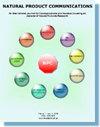Inhibitory Mechanism of the Oregano Essential Oil on the Growth and Biofilm Formation of Streptococcus mutans
IF 1.4
4区 医学
Q4 CHEMISTRY, MEDICINAL
引用次数: 0
Abstract
Objective: The objective was to determine the in vitro antibacterial effect of the Oregano essential oil (OEO) on Streptococcus mutans ( S mutans) and to explore the anti-biofilm effect and mechanism of OEO. Methods: The in vitro antibacterial susceptibility of OEO was detected by the growth curve and colony-forming unit (CFU) counting method. Confocal laser scanning microscope (CLSM) and crystal violet assay were used to explore the anti-biofilm activity of OEO, and the anti-biofilm mechanism was explored from the aspects of extracellular polysaccharides (EPS) synthesis, acidoid, and extracellular DNA changes. OEO was characterized using a gas chromatography-mass spectrometer and cytotoxicity was tested using a cell counting Kit-8 assay. Results: The minimum inhibitory concentration of OEO was 0.25 mg/mL, and the CFU showed the ability of OEO to kill planktonic bacteria. Scanning electron microscopy and CLSM showed that OEO could hinder the development of biofilms, harm bacteria, and eliminate mature biofilms by changing EPS synthesis and pH value. Carvacrol in OEO played a major role in biological antibacterial activity. OEO had low cytotoxicity and good biocompatibility. Conclusions: OEO had excellent antibacterial and anti-biofilm effects on the key virulence traits of S mutans, indicating potential prospects in preventing dental caries.牛至精油对变异链球菌生长和生物膜形成的抑制机制
研究目的目的:测定牛至精油(OEO)对变异链球菌(S mutans)的体外抗菌效果,并探索 OEO 的抗生物膜效果和机制。研究方法通过生长曲线和菌落形成单位(CFU)计数法检测 OEO 的体外抗菌敏感性。采用共聚焦激光扫描显微镜(CLSM)和水晶紫检测法探讨OEO的抗生物膜活性,并从胞外多糖(EPS)合成、类酸和胞外DNA变化等方面探讨其抗生物膜机制。使用气相色谱-质谱仪对 OEO 进行了表征,并使用细胞计数 Kit-8 检测了细胞毒性。结果显示OEO 的最小抑菌浓度为 0.25 mg/mL,CFU 表明 OEO 能够杀死浮游细菌。扫描电镜和CLSM显示,OEO可通过改变EPS的合成和pH值来阻碍生物膜的发展、伤害细菌并消除成熟的生物膜。OEO 中的香芹酚在生物抗菌活性中发挥了重要作用。OEO 的细胞毒性低,生物相容性好。结论OEO 对变形杆菌的主要毒力特征有很好的抗菌和抗生物膜作用,在预防龋齿方面具有潜在的前景。
本文章由计算机程序翻译,如有差异,请以英文原文为准。
求助全文
约1分钟内获得全文
求助全文
来源期刊

Natural Product Communications
工程技术-食品科技
CiteScore
3.10
自引率
11.10%
发文量
254
审稿时长
2.7 months
期刊介绍:
Natural Product Communications is a peer reviewed, open access journal studying all aspects of natural products, including isolation, characterization, spectroscopic properties, biological activities, synthesis, structure-activity, biotransformation, biosynthesis, tissue culture and fermentation. It covers the full breadth of chemistry, biochemistry, biotechnology, pharmacology, and chemical ecology of natural products.
Natural Product Communications is a peer reviewed, open access journal studying all aspects of natural products, including isolation, characterization, spectroscopic properties, biological activities, synthesis, structure-activity, biotransformation, biosynthesis, tissue culture and fermentation. It covers the full breadth of chemistry, biochemistry, biotechnology, pharmacology, and chemical ecology of natural products.
Natural Product Communications is a peer reviewed, open access journal studying all aspects of natural products, including isolation, characterization, spectroscopic properties, biological activities, synthesis, structure-activity, biotransformation, biosynthesis, tissue culture and fermentation. It covers the full breadth of chemistry, biochemistry, biotechnology, pharmacology, and chemical ecology of natural products.
 求助内容:
求助内容: 应助结果提醒方式:
应助结果提醒方式:


